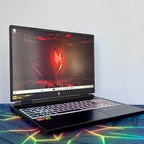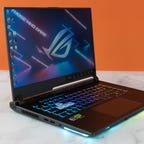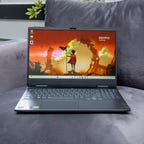Best Cheap Gaming Laptop of 2024
A quality gaming setup doesn’t have to leave you broke. Check out our best budget-friendly gaming laptops of 2024.
What to consider
Price
Budget gaming laptops start at well below $1,000, but the cheapest models have older Nvidia GeForce GTX GPUs that limit your 3D gaming capabilities. The sweet spot is between $800 and $1,000 for a model with at least RTX 4050 graphics.
Operating system
While MacBooks running Apple's MacOS are popular for home, work and school use, Microsoft Windows is the choice for gaming laptops, especially budget gaming laptops.
Screen
Most gaming laptops feature large displays between 15 and 18 inches with budget models usually offering a 15.6-inch or 16-inch screen.
Processor
The processor, also known as the CPU, is the brains of a laptop. Intel and AMD are the main CPU makers for Windows laptops. Generally speaking, the faster the processor speed and the more cores it has, the better the performance will be.
Graphics
All gaming laptops will feature a dedicated GPU from either Nvidia or AMD. Nvidia is the more popular of the two. For budget gaming laptops, you'll see many models with the entry-level RTX 4050 GPU or step-up RTX 4060 GPU as well as older models with previous-generation RTX 3050 or 3060 GPUs.
Memory
For memory, we highly recommend 16GB of RAM, with 8GB being the absolute bare minimum.
Storage
For a gaming laptop, we don't recommend going with less than a 512GB SSD unless you really like uninstalling games every time you want to play a new game.
Our Picks
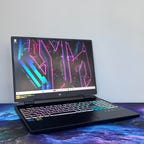
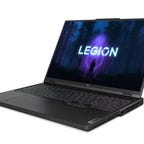
What's the best cheap gaming laptop overall?
The Acer Predator Helios Neo 16 is our pick for the best cheap gaming laptop. Among budget gaming models we’ve tested based on RTX 4050 graphics, it’s the fastest. And it also supplies a big and bright 16-inch, 16:10 display and adds a bit of aluminum to what is usually an all-plastic design at its price. And about the price: It’s a good deal at its full $1,200 price, but becomes a steal when it goes on sale at Best Buy, where we’ve seen it as low as $830.
Acer also takes the runner-up spot for the best budget gaming laptop with the Nitro 16. The two models are very similar, and the Nitro 16 can often be found on sale at Acer and Newegg for as low as $900, where it provides great bang for your gaming buck.
Read more: How to Buy a Gaming Laptop
Our recommendations are based on our reviews and testing. We aim to help you get your ideal gaming experience on a cheap laptop. We'll update this list of the best cheap gaming laptops as we review new products. Also, if you need help deciphering what specs to look for on a good, cheap gaming laptop, we've got some advice below.
Best cheap gaming laptops of 2024
Like other gaming laptop makers, Acer has two lines: a budget-friendly Nitro series and midrange and premium models that carry the Predator label. Oddly enough, it's under the latter you'll find our budget gaming pick: the Helios Neo 16. It's strikingly similar to the Acer Nitro 16 but with slightly better build quality and graphics performance. The only place it faltered was its speakers, which put out disappointingly flat audio with nonexistent bass.
The Predator Helios Neo 16 we reviewed with RTX 4050 costs $1,200. That is high for a budget gaming laptop. The trick is to be patient and wait for a sale -- these happen regularly, and the price drops to $830.
Next best cheap gaming laptop for less than $1,000
Acer Nitro 16
Acer's own Predator Helios Neo 16 may offer better 3D performance for the same price while also adding a bit of aluminum to the design along with a better webcam, but the Nitro 16 also delivers the goods for gamers on tight budgets. It's a well-rounded budget gaming laptop with strong performance from its full-power RTX 4050 GPU, a solid if all-plastic chassis and a big and bright display. The Nitro 16 and Predator Helios Neo 16 models we tested each cost $1,200 but are regularly discounted online. The Nitro 16 is a good buy for those times when you can find it but not the Predator Helios Neo 16 on sale for less than $1,000.
Cheap gaming laptop with best design
Asus ROG Strix G15
Despite having a lot of plastic, the Asus ROG Strix G15 feels pretty well constructed and also offers per-key RGB keyboard backlighting and an underglow strip of LEDs along the front edge, which lets you customize the look of this 15.6-inch budget gamer more than other models that offer multizone RGB lighting at most. And the Strix G15 isn't all flash, delivering a previous-gen but powerful-enough Ryzen 7 6800HS CPU and RTX 3050 GPU for $1,000. And it's often on sale for less. We also like getting 16GB of RAM instead of the meager 8GB that you sometimes find at this price.
Best cheap gaming laptop with big, bright and fast display
Lenovo Legion Pro 5i Gen 8
The 16-inch Legion Pro 5i Gen 8 is an updated version of the 15-inch Legion 5i Pro we reviewed and like last year for its strong performance for the price and bright, fast display. The latest 16-inch version supplies a high-res 2,560x1,600-pixel, 165Hz display, and you can upgrade to an even faster 240Hz panel. Intel's 13th-gen Core processors are on offer along the latest RTX 4050, 4060 and 4070 GPUs. Lenovo constantly rotates discounts, so pricing is always a moving target. But right now, the Legion Pro 5i Gen 8 costs $1.035 for a Core i5/RTX 4050 config.
Cheapest laptop with RTX 4050 graphics
Lenovo IdeaPad Gaming 3
The IdeaPad Gaming 3 has neither the most exciting design nor the brightest, fastest display, but this 15.6-inch budget gaming laptop is only $800 at Amazon for a configuraiton with an AMD Ryzen 7 7735HS processor, 16GB of RAM and RTX 4050 graphics. The tradeoff for getting such a low price is putting up with a dull, 250-nit display and low-res 720p webcam.That's a solid lineup for the price. It's a great pick if you are looking for your first gaming laptop and don't have a lot to spend.
Other laptops we've tested
Dell XPS 14 9440: The radical look is sure to turn heads, but some of the daring design elements could be turn-offs.
Lenovo Slim 7i: With an OLED display and a solid build, this is a rugged option for mainstream shoppers, but other touches are decidedly midrange.
Dell Inspiron 14 Plus 7440: For a reasonable $1,000, this 14-inch Dell model, based on an Intel Core Ultra CPU, lets you be highly productive on the go.
Alienware m16 R2: This midrange option for mainstream gaming fares better than average and is a sensible option for 1440p play.
Acer Predator Triton 14: With fast performance and a bright HDR screen, this mainstream 14-inch gaming laptop can be a great gaming value.
M3 MacBook Air 13: Apple's 2024 MacBook Air update is a straightforward performance boost to power you through the future of work, school and play, at home or away.
Lenovo LOQ 15: Lenovo's entry-level model is the opposite of flashy, but it gives good performance and it's one of the cheapest RTX 4050 models (at least on sale).
HP Victus 16: It’s speedy and svelte, but gamers on tight budgets deserve better than this laptop's basic 60Hz panel.
MSI Cyborg 15 Review: It's one of the lowest-cost RTX 4050 laptops, but the Cyborg 15's GPU is restricted from running at full power, which puts a cap on 3D performance. And its display disappoints, too.
Asus ROG Zephyrus G14: Standout profiling and calibration for its class makes Asus' first OLED in the line stand out from the crowd.
Lenovo ThinkPad Z13 Gen 2: It breaks with the ThinkPad tradition in many ways without abandoning the things that make it a ThinkPad.
Lenovo ThinkPad X1 Yoga Gen 8: This 14-inch two-in-one for business users is compact for easy travel yet big enough to get work done, but its display options miss the mark.
Acer Swift Go 14 (2024): Intel's new Core Ultra CPU gives this unassuming 14-inch laptop great battery life and a bit of a speed boost -- with potential AI acceleration down the road.
MSI Modern 14 C13M: Its audio-visual output won't wow you, but MSI's 14-inch budget offering boasts good build quality and competitive performance.
HP Dragonfly G4: HP's compact premium business laptop stands out with its unusual 3:2 display and unique dual-webcam capability.
How we test laptops
The review process for laptops consists of two parts: performance testing under controlled conditions in the CNET Labs and extensive hands-on use by our reviewers. This includes evaluating a device's aesthetics, ergonomics and features with respect to price. A final review verdict is a combination of both objective and subjective judgments.
We test all laptops with a core set of benchmarks, including Primate Labs Geekbench 6, Cinebench R23, PCMark 10, a variety of 3DMark benchmarks (whichever can run on the laptop), UL Procyon Photo and Video (where supported), and our own battery life test. If a laptop is intended for gaming, we'll also run benchmarks from Guardians of the Galaxy, The Rift Breaker (CPU and GPU) and Shadow of the Tomb Raider.
For the hands-on, the reviewer uses it for their work during the review period, evaluating how well the design, features (such as the screen, camera and speakers) and manufacturer-supplied software operate as a cohesive whole. We also place importance on how well they work given their cost and where the manufacturer has potentially made upgrades or tradeoffs for its price.
The list of benchmarking software and comparison criteria we use changes over time as the devices we test evolve. You can find a more detailed description of our test methodology on our page on how we test computers.
Factors to consider when buying a gaming laptop
For gamers on a tight budget, the trick to finding the right gaming laptop is getting enough performance to play 3D games without sacrificing too much in other areas like the display and overall build quality -- while also avoiding older models on sale with outdated or soon-to-be-outdated parts. Here's our expect advice on what to consider to get the most gaming laptop for your money.
Price
The search for an affordable gaming laptop for most people starts with price. The good news is you can find a perfectly serviceable gaming laptop with modern components capable of playing today's games for roughly $1,000. And sometimes less than that if you find a model on sale. Dell, HP, Lenovo and other manufacturers are constantly rotating discounts, so you can lock in a great deal if you time it right.
If your budget allows you to spend more than $1,000, you'll find models with more powerful components and brighter and faster displays along other bonuses like per-key RGB lighting and thinner designs.
Operating system
While MacBooks running Apple's MacOS are popular for home, work and school use, Microsoft Windows is the choice for gaming laptops, especially budget gaming laptops. You can run some games on higher-end MacBook Pros, but they are very expensive compared with cheap, Windows-based gaming laptops.
If you are on a tight budget, you could consider a Chromebook. ChromeOS is a different experience than Windows -- more streamlined and easier to use. But limited in that basically everything runs through the Chrome browser. Still, there are some Chromebooks for gamers.
Screen
Most gaming laptops feature either a 15-inch or 16-inch screen, although you'll see some smaller 14-inch models as well as a few 17- and even 18-inch behemoths. Newer 16-inch models with taller 16:10 aspect ratios are starting to replace 15.6-inch with a more traditional 16:9 widescreen ratio, and we generally favor the boxier 16-inch models. You'll likely do most of your gaming at a 1,920x1,080-pixel resolution, which has a 16:9 ratio, but the more vertical space afforded with a 16:10 display makes the laptop more useful outside of gaming when you are scrolling through web pages and long documents.
Another important display spec for gamers is refresh rate -- the number time times per second a display refreshes its image. Most gaming laptops, even cheap ones, have displays with variable refresh rates that can sync to the frames per second of a game to prevent artifacts like tearing (where it looks like parts of different screens are mixed together) and stutter (where the screen updates at perceptibly irregular intervals).
All the major companies have bumped their flagship 1080p configurations to 360Hz, but for many gamers, they're not essential: 240Hz max should be fine for those few times you can get frame rates above 240fps. On cheaper gaming laptops, you'll generally see 120Hz, 144Hz and 165Hz refresh rates, which should suffice if you have a lower-end GPU that won't push frames rates past 165 fps.
Even if you don't plan on playing games at resolutions higher than 1080p, we suggest getting the highest resolution you can afford. Because on a larger 15 or 16-inch laptop display, text and the edges of images can look fuzzy on a 1080p -- or a 1,920x1,200-pixel resolution on laptops with a 16:10 aspect ratio. A Quad HD (QHD) resolution of 2,560×1,440 pixels (2,560×1,600 on a 16:10 display) will result in crisper text and images, and you can always choose to play games at a resolution lower than the maximum.
Processor
The processor, aka the CPU, is the brains of a laptop. Intel and AMD are the main CPU makers for Windows laptops. Both offer a staggering selection of mobile processors. Making things trickier, both manufacturers have chips designed for different laptop styles, like power-saving chips for ultraportables or faster processors for gaming laptops. Their naming conventions will let you know what type is used. You can head to Intel's or AMD's sites for explanations so you get the performance you want. Generally speaking, though, the faster the processor speed and the more cores it has, the better the performance will be.
Graphics
The graphics processor, or GPU, handles all the work of driving the screen and generating what gets displayed, as well as speeding up a lot of graphics-related (and increasingly, AI-related) operations. For Windows laptops, there are two types of GPUs: integrated (iGPU) or discrete (dGPU). As the names imply, an iGPU is part of the CPU package, while a dGPU is a separate chip with dedicated memory (VRAM) that it communicates with directly, making it faster than sharing memory with the CPU. All gaming laptops will feature a dGPU from either Nvidia or AMD. Nvidia is the more popular of the two. For budget gaming laptops, you'll see many models with the entry-level RTX 4050 GPU or step-up RTX 4060 GPU as well as older models with previous-generation RTX 3050 or 3060 GPUs.
Memory
For memory, we highly recommend 16GB of RAM, with 8GB being the absolute bare minimum. RAM is where the operating system stores all the data for currently running applications, and it can fill up fast. After that, it starts swapping between RAM and SSD, which is slower. Also, many laptops now have the memory soldered onto the motherboard. Most manufacturers disclose this, but if the RAM type is LPDDR, assume it's soldered and can't be upgraded.
Some PC makers will solder memory on, however, and also leave an empty internal slot for adding a stick of RAM. You may need to contact the laptop manufacturer or find the laptop's full specs online to confirm. And check the web for user experiences, because the slot may still be hard to get to, it may require nonstandard or hard-to-get memory or other pitfalls, including voiding the warranty.
Storage
You'll still find cheaper hard drives in budget laptops and larger hard drives in gaming laptops, but faster solid-state drives have all but replaced hard drives in laptops. They can make a big difference in performance. For a gaming laptop, we don't recommend going with less than a 512GB SSD unless you really like uninstalling games every time you want to play a new game.




